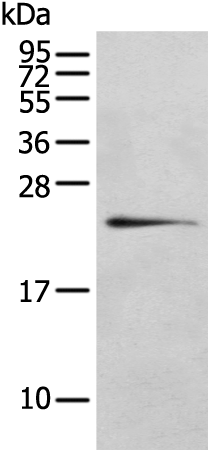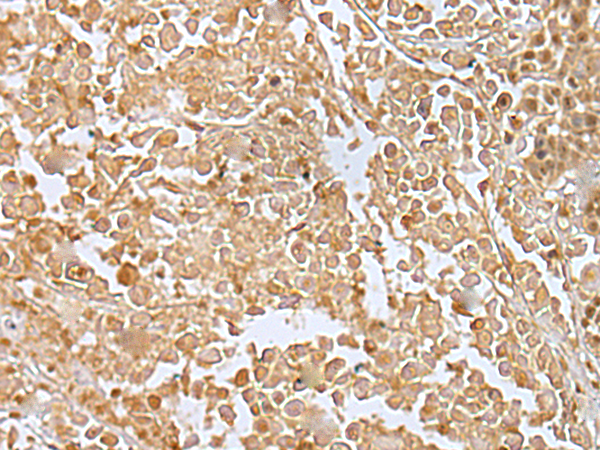

| WB | 咨询技术 | Human,Mouse,Rat |
| IF | 咨询技术 | Human,Mouse,Rat |
| IHC | 1/25-1/100 | Human,Mouse,Rat |
| ICC | 技术咨询 | Human,Mouse,Rat |
| FCM | 咨询技术 | Human,Mouse,Rat |
| Elisa | 1/5000-1/10000 | Human,Mouse,Rat |
| Aliases | RLP2 |
| WB Predicted band size | 24 kDa |
| Host/Isotype | Rabbit IgG |
| Antibody Type | Primary antibody |
| Storage | Store at 4°C short term. Aliquot and store at -20°C long term. Avoid freeze/thaw cycles. |
| Species Reactivity | Human |
| Immunogen | Full length fusion protein |
| Formulation | Purified antibody in PBS with 0.05% sodium azide and 50% glycerol. |
+ +
以下是关于RILPL2抗体的3篇参考文献,按文献名称、作者和摘要内容概括整理:
---
1. **"RILP interacts with RAB8A and regulates ciliogenesis via modulation of the RAB8A-GEF interaction"**
**作者**: Kunimoto et al. (2012)
**摘要**: 该研究通过RILPL2抗体进行免疫荧光实验,发现RILPL2与RAB8A蛋白结合,调控其鸟苷酸交换因子(GEF)的活性,从而影响初级纤毛的形成和细胞极化过程。
2. **"CEP97 and CP110 coordinate the assembly and disassembly of the primary cilium by regulating RILPL2 localization"**
**作者**: Lu et al. (2015)
**摘要**: 利用RILPL2抗体进行亚细胞定位分析,发现CEP97和CP110通过调控RILPL2在中心体周围的定位,参与纤毛发生和中心体复制的动态平衡,揭示其在细胞周期中的关键作用。
3. **"Phosphorylation of RILPL2 at Serine 402 disrupts its interaction with 14-3-3 proteins and promotes ciliogenesis"**
**作者**: Watanabe et al. (2016)
**摘要**: 研究通过Western blot和免疫共沉淀实验(使用RILPL2抗体),证明RILPL2的磷酸化修饰影响其与14-3-3蛋白的结合能力,进而调控纤毛生成的信号通路,为纤毛相关疾病提供潜在机制。
---
以上文献均涉及RILPL2在细胞骨架调控和纤毛形成中的功能研究,并通过RILPL2抗体进行蛋白定位、互作或修饰分析。如需扩展,可进一步检索PubMed等数据库获取更多细节。
The RILPL2 (Rab Interacting Lysosomal Protein-Like 2) antibody is a tool used to study the RILPL2 protein, a member of the Rab-interacting lysosomal protein family. RILPL2 is implicated in intracellular trafficking and cilium formation through its interaction with Rab GTPases, particularly Rab8 and Rab10. which regulate vesicular transport and membrane dynamics. It plays a role in primary cilia assembly by recruiting ciliary components and modulating microtubule organization. Dysregulation of RILPL2 has been linked to ciliopathies, neurodegenerative disorders, and cancer, making it a subject of interest in cellular and disease research.
The RILPL2 antibody is typically generated using recombinant protein fragments or synthetic peptides to ensure specificity. It is widely used in techniques like Western blotting, immunofluorescence, and immunohistochemistry to detect RILPL2 expression, localization, and interaction partners in cell lines or tissue samples. Studies utilizing this antibody have revealed RILPL2's involvement in ciliogenesis, cell cycle regulation, and autophagy pathways. Recent research also explores its potential role in cancer progression, particularly in glioblastoma and ovarian cancer, where altered RILPL2 expression correlates with tumor invasiveness. Validation steps, such as knockout controls or siRNA knockdown, are critical to confirm antibody specificity due to homology within the RILP protein family.
×